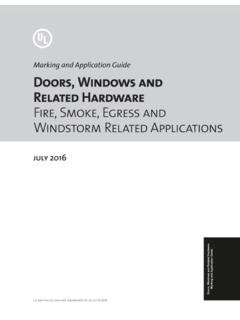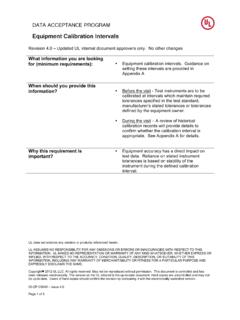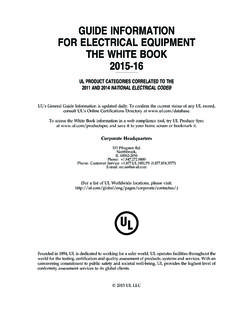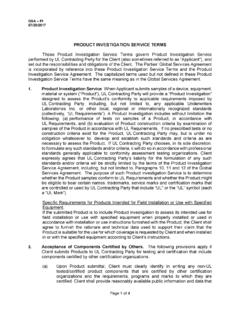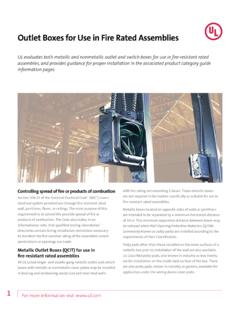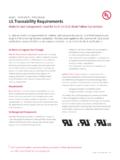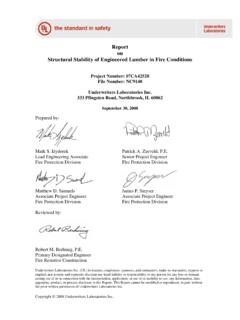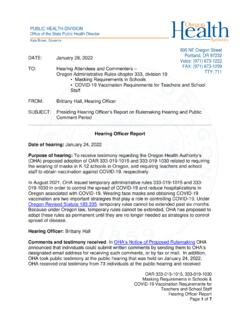Transcription of COMPLIANCE GUIDELINES FOR MARKING AND LABELING …
1 COMPLIANCE GUIDELINES FOR MARKING AND LABELING SYSTEMSMost electrical products and equipment are required to be marked with specific safety-related information and meet permanency of MARKING requirements. These markings can include electrical ratings, use instructions, warnings regarding potential safety hazards, and cautionary markings. COMPLIANCE with permanency of MARKING requirements helps ensure that the labels will adhere to the application surface, and that the text will remain legible for the product s intended UL white paper discusses the specifics of MARKING and LABELING requirements, and how to identify compliant MARKING and LABELING systems for use by product and equipment manufacturers.
2 Beginning with a definition of MARKING and LABELING systems, the paper will then briefly review the testing and evaluation protocol required under current MARKING and LABELING standards. The white paper then discusses the process for sourcing compliant MARKING and LABELING systems, and concludes with recommendations for both end-product manufacturers and label converters and Are MARKING and LABELING Systems?Labels (also referred to as nameplates or markers) convey a wide range of information regarding the safe installation or use of a given product. For example, information about a product s electrical rating can help confirm compatibility with an electrical system or other product, thereby preventing circuit overloads or product failures.
3 Other information can warn users about the risk of electric shock under certain operating conditions such as proximity to water or sources of moisture. In other cases, labels can provide the user with information about appropriate use environments, , for indoor use only or how to properly use the product. Government regulations, codes such as the National Electric Code and product safety standards, as well as many distributors and retailers, often stipulate that products need to meet applicable safety requirements. These product requirements usually prescribe requirements for the permanence of markings when a label is being used to convey safety-related information, including hazards, warnings, cautionary markings, installation instructions and electrical ratings.
4 Even in cases where safety standards don t apply, original equipment manufacturers (OEMs) often specify MARKING performance requirements to their label suppliers. At UL, these types of labels are referred to as MARKING and LABELING systems. page 2 COMPLIANCE GUIDELINES for MARKING and LABELING Systemspage 3 COMPLIANCE GUIDELINES for MARKING and LABELING SystemsStandards that Address the Permanence of MarkingWhether mandated by regulations, codes, retailers or manufactures themselves, specific permanence of MARKING performance requirements are often required for products such as appliances, consumer electronics, motors, lighting, medical equipment, and more.
5 There are a number of permanence of MARKING standards for labels, but two of the most widely referenced are ANSI/UL 969, the Standard for Safety of MARKING and LABELING Systems, and CSA No. , Adhesive Labels. ANSI/UL 969, MARKING and LABELING Systems UL 969 was first published in 1978 and is considered the de facto performance standard for durable safety label requirements around the world. UL 969 is referenced in over 450 UL and over 30 ULC end-product standards, and is mentioned in ASTM, NFPA, ANSI, and manufacturer specifications, making it the most widely referenced label standard in the supply chain. UL 969 covers adhesive attached labels (pressure sensitive, heat activated or solvent activated) and in-mold labels for use as permanent nameplates or markers, that provide information, instructions or identification in the form of text or pictographs.
6 The Standard outlines specific criteria regarding the permanence and legibility of the labels as well as the test procedures required to determine COMPLIANCE . Under the Standard, labels are evaluated as complete systems, , overlamination, ink and stock, on specific surface materials for use in dry indoor environments, indoor environments in which a label may be exposed to water or high humidity, or outdoor environments. Additional environmental conditions, such as exposure to oils, detergents or gasoline, can also be evaluated. Since most safety standards and manufacturers reference UL 969 requirements, labels found to meet the requirements of this Standard are considered suitable for use with a wide range of products, greatly reducing testing and supply chain complexity.
7 CSA No. , Adhesive Labels Canadian Standards Association (operating as CSA Group ) standard No. was first published in 1990 and covers the performance requirements of labels used for products evaluated to CSA standards. It has a similar scope to UL 969 and also covers testing procedures and performance requirements of labels. However, the CSA and UL standards are not harmonized, and the test methods, conditions, and performance requirements presented in the standards differ. Label Requirements of Other Standards Some safety standards have chosen to utilize their own label performance requirements instead of a globally recognized standard like UL 969.
8 Examples of these standards include ANSI portable ladder standards, UL 299 for dry chemical fire extinguishers and IEC-based standards. In other cases, safety standards may cover requirements for labels used as tags that are securement-strap attached, flag type, or wrapped around a cord or hose. In these specialized cases, the product safety standard has specific requirements that differ from typical products; therefore, labels used in these instances are required to be evaluated against the specialized performance requirements of the particular product 4 COMPLIANCE GUIDELINES for MARKING and LABELING SystemsTesting and Evaluation The evaluation for MARKING and LABELING systems includes both a construction examination and testing for permanence.
9 The test program involves evaluating the performance of each system on an actual or representative end-product surface after being subjected to environmental conditions that simulate the conditions that would be encountered in the label s intended use, , indoor , outdoor, etc. Construction ExaminationThe construction examination is used to verify and document the construction of the label being evaluated. It involves identifying the different layers of the label and their thickness, and confirming whether the label incorporates an overlamination, varnish or support stock. The construction examination also identifies the layer or layers to which the ink is applied, , top-surface or sub-surface, and confirms the generic type of label stock employed, , paper or polymer-based.
10 UL 969 and other MARKING and LABELING standards typically specify only performance requirements and do not mandate the use of specific label materials. Testing for PermanencyUL 969, CSA No. , and most other MARKING and LABELING standards utilize environmental conditioning of labels prior to their evaluation for label permanency. After applying label samples to the actual or representative test surfaces, the labels are conditioned in various exposures, such as water immersion, elevated and lowered temperatures, chemical immersions, and ultraviolet (UV) weathering. After environmental conditioning has been completed, label COMPLIANCE is determined by visually examining the samples for evidence of curling, wrinkling, shrinkage or loss of adhesion around the perimeter.

